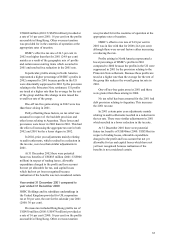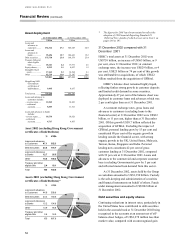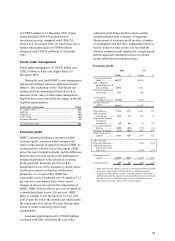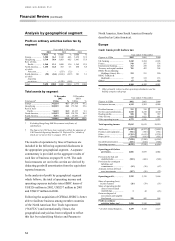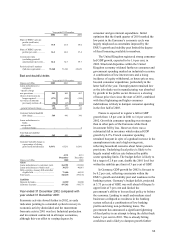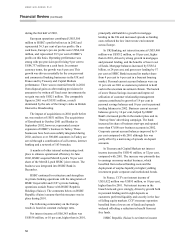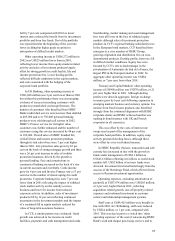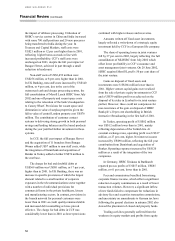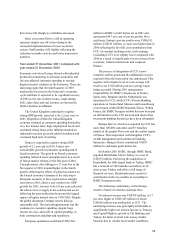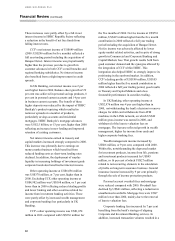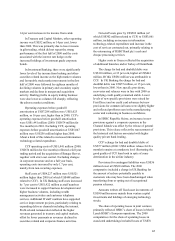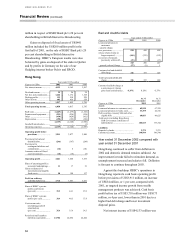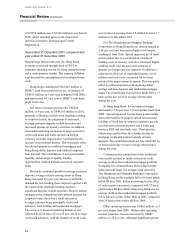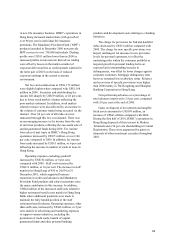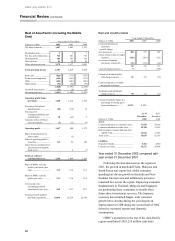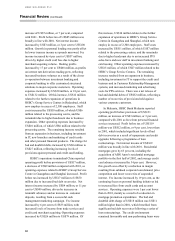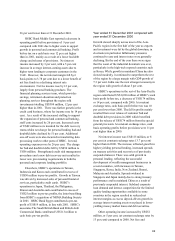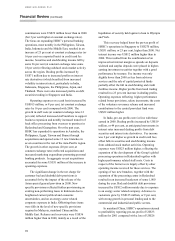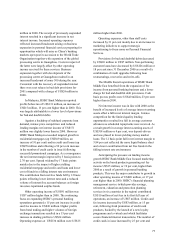HSBC 2002 Annual Report Download - page 63
Download and view the complete annual report
Please find page 63 of the 2002 HSBC annual report below. You can navigate through the pages in the report by either clicking on the pages listed below, or by using the keyword search tool below to find specific information within the annual report.61
14 per cent increase in fee income from cards.
In Treasury and Capital Markets, other operating
income was US$52 million, or 14 per cent, lower
than 2000. This was primarily due to lower income
in gilts trading, which did not repeat the strong
performance of the first half of 2000 and the costs
associated with the interest rate hedge on the
increased holdings of investment grade corporate
bonds.
In Investment Banking, there were significantly
lower levels of fee income from broking and other-
securities related income as the high market volumes
and favourable stock market movements in the first
half of 2000 were followed by eighteen months of
declining volumes in primary and secondary equity
markets and declines in merger and acquisition
activity. Dealing profits in equity trading business
were also lower as volumes fell sharply, reflecting
the adverse market conditions.
Operating expenses before goodwill
amortisation at US$7,288 million were US$1,023
million, or 16 per cent, higher than in 2000. CCF’s
operating expenses before goodwill amortisation
were US$1,441 million (2000: US$674 million for
five months) in 2001. Excluding CCF, operating
expenses before goodwill amortisation at US$5,847
million were US$256 million higher than 2000.
About a third of this related to increased information
technology-related expenditure.
CCF operating costs of US$1,441 million (2000:
US$674 million for five months) reflected a full year
trading period and the acquisition of Banque Hervet,
together with strict cost control. Excluding changes
in corporate structure and on a full year basis,
operating costs increased by only 1.7 per cent,
mainly from non-recurring expenses.
Staff costs at US$4,227 million were US$521
million higher than 2000 (of which US$448 million
related to CCF) . In UK Banking staff costs increased
by 7 per cent to US$1,922 million as staff numbers
were increased to support business development and
higher business volumes, including wealth
management activities and customer telephone
services. Additional IT staff numbers have supported
service improvement projects, particularly relating to
expanding delivery channels including the internet.
Profit-related remuneration reflected the higher
revenues generated in treasury and capital markets,
offset by lower payments as revenues declined in
securities related and corporate finance activities.
Non-staff costs grew by US$502 million (of
which US$302 million related to CCF) to US$3,061
million, including an increase in information
technology-related expenditure and increase in the
cost of services contracted out, primarily relating to
the outsourcing of HSBC Bank plc’s cash and
cheque processing services.
Higher costs in Greece reflected the acquisition
of additional branches and in Turkey of Demirbank.
The charge for bad and doubtful debts was
US$110 million, or 33 per cent, higher at US$441
million. Of this US$81 million was attributable to
CCF. In UK Banking the charge for bad and
doubtful debts was US$57 million, or 15 per cent,
lower than in 2000. New specific provisions,
recoveries and releases were in line with 2000 as
underlying credit quality remained stable. Lower
levels of new specific provisions were raised for
First Direct and on credit card advances but new
provisions for commercial loans were slightly higher
and reflected problems seen in the manufacturing
sector and weakening in business confidence.
In HSBC Republic Suisse, an increase in new
provisions against a corporate exposure in the
Channel Islands was offset by the release of general
provisions. This release reflects the reassessment of
the historical risk factors associated with higher
quality private bank lending.
CCF’s charge for bad and doubtful debts of
US$77 million (2000: US$4 million release for five
months) remains at a moderate level illustrating the
good quality of CCF loan book in spite of some
deterioration in the airline industry.
Provisions for contingent liabilities were US$36
million lower at US$30 million. The 2000
comparative included a charge in UK Banking for
the amount of redress potentially payable to
customers who may have been disadvantaged when
transferring from or opting out of occupational
pension schemes.
Amounts written off fixed asset investments of
US$90 million arose mainly from venture capital
investments and holdings of emerging technology
stocks.
The share of operating losses in joint ventures
primarily reflected HSBC’ s share of losses in Merill
Lynch HSBC’s European operations. The 2000
comparatives for the share of operating losses in
associated undertakings included losses of US$76


